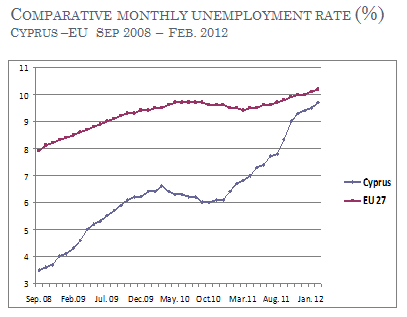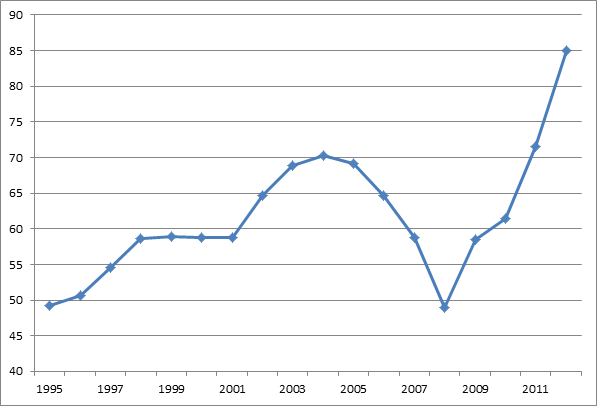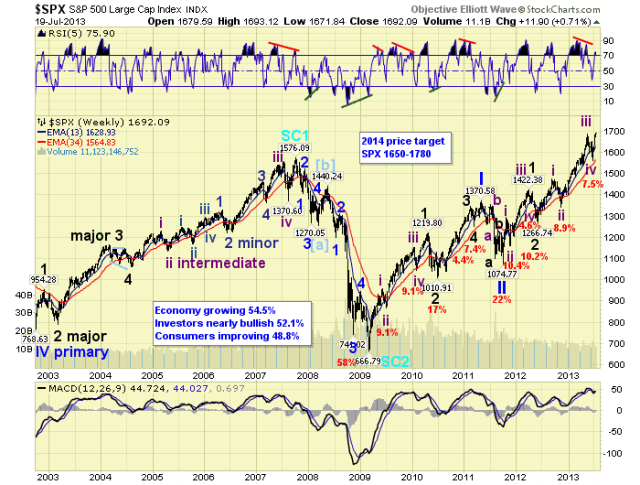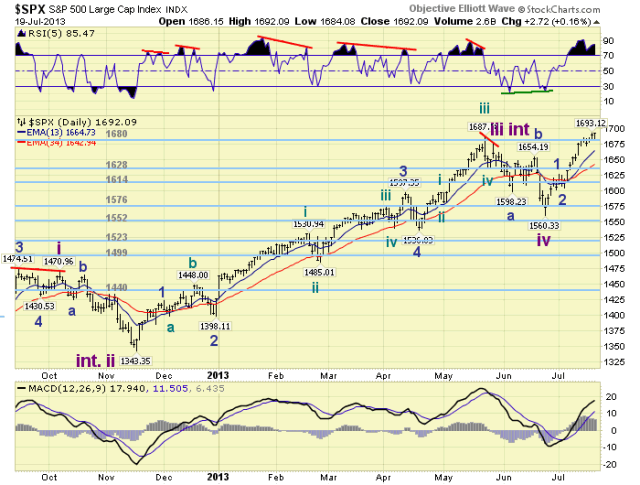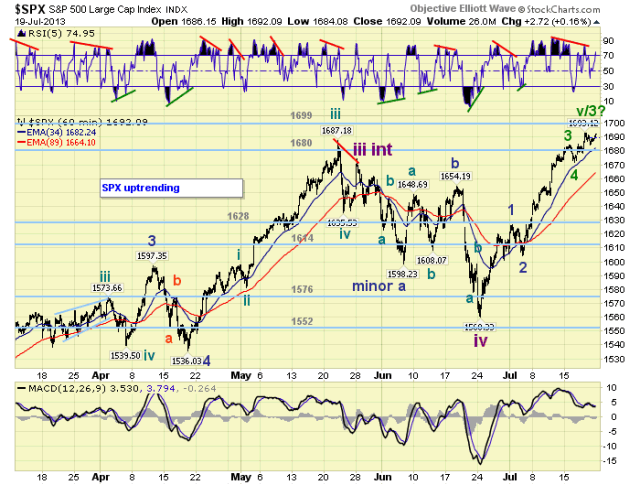By: John_Mauldin
By a continuing process of inflation, governments can confiscate, secretly and unobserved, an important part of the wealth of their citizens. By this method, they not only confiscate, but they confiscate arbitrarily; and, while the process impoverishes many, it actually enriches some. The sight of this arbitrary rearrangement of riches strikes not only at security, but at confidence in the equity of the existing distribution of wealth. Those to whom the system brings windfalls . . . become 'profiteers', who are the object of the hatred of the bourgeoisie, whom the inflationism has impoverished not less than the proletariat. As the inflation proceeds . . . all permanent relations between debtors and creditors, which form the ultimate foundation of capitalism, become so utterly disordered as to be almost meaningless…. – John Maynard Keynes
One of the more frequent and important questions I get asked when I travel is whether I think we will see inflation or deflation. My usual flippant answer is "Yes," and then I go on to explain that there is no simple answer. Over what time period? In what country? And by what means do you want me to measure inflation or deflation? Today we take a look at part of a white paper I am working on with Jonathan Tepper, the co-author of Endgame, on this topic. I think you will find it interesting reading on a summer's day. And I have to quickly mention the absolute disaster that is happening before our eyes in the labor market. Our kids are getting skewered (the polite word) by unintended consequences of the Affordable Care Act. We need a bipartisan fix quick, before we damage an entire generation.
But first, let me call your attention to a dynamite conference at which I'll be speaking in October. It's "3 Days with Casey," the Casey Research Summit for 2013, to be held October 4-7 in Tuscon, Arizona. In addition to the indomitable, incredible Doug Casey, my friends Ron Paul, Lacy Hunt, Rick Rule, and Don Coxe will all stand and deliver, along with a bunch of other outstanding speakers, including Jim Rickards (author of Currency Wars), Paul Brodsky (I love this guy's stuff!), and Chris Martenson (author of The Crash Course). And of course you get the whole Casey research team. Thoughts from the Frontline readers can get a special early bird discount here. Come help me celebrate my 64th birthday!
A Temporary Problem
Back in 2010, a number of analysts (including me) noted an unintended consequence buried in the Affordable Healthcare Act (aka ObamaCare). Employers are not required to provide insurance for temporary workers, and a temporary worker is defined as someone who works under 29 hours per week. Many of us noted that this would result in businesses shifting workers from full-time to part-time. The answer from AHA supporters was that "No, it wouldn't" or that the effect would be small. There was no real way to know, of course. I and others could only point to our experience of how the real world works. If you defined the cut-off for part-time work at 35 or 39 hours a week instead of 29, the economics of ObamaCare simply got blown out of the water. But the bill passed, and now it's law.
And now the argument is over. It is clear that businesses have indeed responded to the rather perverse incentives in the law. A year ago, growth in full-time employment far outpaced increases in temporary employment. That trend has reversed this year. Mort Zuckerman wrote in an op-ed piece in the Wall Street Journal this week:
The jobless nature of the recovery is particularly unsettling. In June, the government's Household Survey reported that since the start of the year, the number of people with jobs increased by 753,000 – but there are jobs and then there are "'jobs."' No fewer than 557,000 of these positions were only part-time. The June survey reported that in June full time jobs declined by 240,000, while part-time jobs soared 360,000 and have now reached an all-time high of 28,059,000 – three million more part-time positions than when the recession began at the end of 2007.
That's just for starters. The survey includes part-time workers who want full-time work but can't get it, as well as those who want to work but have stopped looking. That puts the real unemployment rate for June at 14.3%, up from 13.8% in May.
The US Chamber of Commerce summarizes the situation:
"Small businesses expect the AHA requirement to negatively impact their employees. Twenty-seven percent say they will cut hours to reduce full-time employees, 24 percent will reduce hiring, and 23 percent plan to replace full-time employees with part-time workers to avoid triggering the mandate."
Younger people and those whose jobs could readily be farmed out to plenty of potential replacements are in danger. There are many jobs that can almost as easily be done by two people working 20-25 hours as by person working 40-50 hours. And that is what is happening. As Zuckerman notes, if you count those who have only temporary employment though they want full-time work, the unemployment rate rose last month from 13.8% to 14.3%. This is recovery?
I have seen this happen in my own family (and to a union member, no less!). How can you support yourself on a part-time job? Juggling two part-time jobs takes a lot more than 40 hours a week and increases the costs of getting to and from work. And under the AHA, the government, not the employer(s), is going to have to pick up that bill if a part-time worker is going to have health insurance.
Republicans want to repeal ObamaCare. Many are not interested in anything short of that outcome. Democrats don't want to change anything and won't touch legislative fixes, afraid to be seen as opening up the whole issue before the next mid-term elections. But we are seriously damaging the ability of people to get work and be able to support themselves and especially the opportunity for younger people to get work that can result in acquiring skills and moving upward on the income scale. The definition of part-time should revert to the traditional standard: if you work less than 40 hours a week, you are part-time.
I get that that destroys the economics of ObamaCare. But do we want to see our children as unintended casualties in a political war over healthcare? A bill has been introduced to fix this problem in the Senate. The US Chamber of Commerce survey is telling us the direction we are currently headed in. Do we really want to wait until things get even worse?
And now, let's think about inflation, together with my co-author, Jonathan Tepper.
Any Bonds Today?
Can you imagine Julia Roberts and Gwyneth Paltrow helping the US government sell bonds or Jay Z and Justin Timberlake composing songs about Treasury bills? It would not be the first time Hollywood stars or famous musicians tried to help the government sell its debt.
The last time the US government had an enormous load of debt, it used Hollywood stars to help sell government debt. The Treasury Department conducted a massive public relations campaign through radio, newspapers, and film. During World War II, war bond rallies were held throughout the country, and Hollywood stars such as Bette Davis and Rita Hayworth traveled around the country to promote war bonds. The great Irving Berlin even wrote a song titled "Any Bonds Today?" and Berlin's tune became the theme song of the Treasury Department's National Defense Savings Program.
The government also enlisted cartoon characters, actors, comedians, and musicians to encourage people to pay income taxes. Donald Duck told viewers it was their "duty and privilege" to pay income tax. Abbott and Costello appeared in advertisements to get people to pay taxes, and Irving Berlin wrote songs not only about bonds but songs about taxes like "I Paid My Income Tax Today."
While the war bond and income tax drives garnered all the press, the real reason the US was able to borrow so much and with so little burden had nothing to do with the glitz and glamor of movie stars. The US government borrowed easily because the Federal Reserve printed money to keep interest rates low. Borrowing is very easy when a central bank has your back.
How did it work in practice? As is the case today, the Treasury wanted to borrow cheaply then, and the central bank was happy to accommodate. In 1942, after the United States entered World War II, the Federal Reserve officially agreed to fix interest rates on government bonds at a low level. To maintain the pegged rate, the Fed was forced to give up control of the size of its balance sheet. Unsurprisingly, the Fed bought and held all available short-term US treasuries and almost all long-term government bonds.
The costs of paying for World War II pushed the national debt up sharply, from around 40% of GDP before the war to a peak of nearly 110% as the war ended. But a combination of strong economic growth, tight fiscal policies, and financial repression brought the debt back below 50% of GDP by the late 1950s. (Currently our government debt has reached about 90% of GDP and continues climbing very sharply.)
During the war years, the Federal Reserve pegged long-term interest rates at extremely low levels so the government wouldn't have to pay much to fund itself. To make sure that inflation didn't spike, the government instituted wage and price controls. After the war, the price controls disappeared and inflation rose very quickly, averaging about 6.5 percent annually from 1946-51. By the postwar price peak nine years later, wholesale prices had more than doubled, and the stock of money had nearly tripled.
Normally, such high inflation would have made it much more expensive for the government to borrow money. But after being pressured by the Treasury, the Federal Reserve agreed to keep on pegging long-term government bond yields at 2.5% until the spring of 1951, when the Federal Reserve finally refused to print money to keep bond yields low. Because of the coordination between Federal Reserve and the US Treasury, real yields on government bonds were very negative during the years following World War II. With negative real yields, borrowers win and lenders lose. The clear winner was the US government, and the loser was anyone who bought and held US bonds. The combination of very low government bond borrowing costs and high inflation ate away a sizable chunk of the government's debt burden.
The same thing is happening today in almost all government bond markets around the world. Governments are winning, and investors are losing. The Federal Reserve is helping the Treasury to borrow cheaply while the government expands its deficit spending and debt accumulation. Using inflation and low bond yields this way to reduce government debt is called financial repression.
The government and central banks also contribute to higher inflation by pretending inflation is always under control. For example, throughout the Greenspan and Bernanke years, the Fed consistently chose to focus on lower inflation measures whenever doing so suited the central bank. You can see this in the semiannual monetary policy reports to Congress, specifically in the inflation forecasts made by the members of the Federal Open Market Committee. Until July 1988, inflation forecasts used the implicit deflator of the gross national product, but then the Fed switched to the Consumer Price Index. In February 2000, the Fed replaced CPI with the personal consumption expenditures (PCE) deflator. Thus from July 2004 onward, inflation forecasts have employed the core PCE deflator that excludes food and energy prices. Using lower and lower, less comprehensive estimates for inflation has allowed the Fed to pretend that it is meeting its mandate – but by ignoring high in flation readings. In the meantime, interest rates have been kept too low, and the inflation rate has consistently remained above the Federal Funds rate.
But measuring inflation is not so easy. The vast majority of readers have no idea about the rather contentious nature of the debates that go on in academic conferences about arcane topics such as the minutiae of how to measure some minor aspect of inflation. Passions run deep. Careers are made. Once you delve into how things are actually done, you realize that what we think of as an inflation number is actually an approximation of an idea the very definition of which can change over time.
Your perception of inflation (and everyone else's) has a very close relationship to how stock markets perform over time. Indeed, one of the questions we are both regularly asked wherever we speak is something along the lines of "What do you think inflation or deflation will be?" And the answer is not easy: it depends on a number of factors that vary from country to country.
In general, the trend for the last 75 years has been one of inflation. Sometimes, in some countries, inflation has spun out of control. At other times you see outright deflation. Neither one promises good times for investors. Ever-falling inflation or low inflation is the best environment for investing. But given the paramount importance of the inflation/deflation debate, we need to briefly investigate what inflation is and is not.
There has been a great deal written about the difficulty of measuring inflation and about the potential manipulation of inflation statistics over the last 30 years. John Williams of ShadowStats is the most-noted proponent of the position that inflation is running well above the current US government's number of 2% (for the 12 months ending February 2013).
Employing the methodology that was used in 1980 under the Carter administration, inflation would currently be about 9.6% (see chart below). Using the government methodology from 1990, inflation today turns out to be a little under 6%.
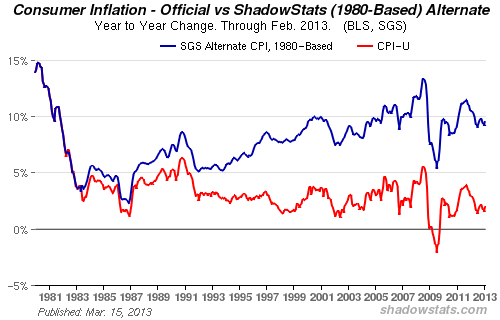
(Fair warning: The following will be regarded as a contentious statement by the gold bugs and hyperinflationists out there. For some of you, to accept it would be like admitting your religious beliefs are wrong.)
The topic of those alternate inflation numbers comes up often at our tables of conversation. Generally it seems to be clear that the methodologies used in 1980 and 1990 are visibly, patently, demonstrably wrong. If inflation were now at 9.6%, then interest rates should be closer to 12% and not the 1.75% we see on the 10-year Treasury today (more on that topic in a minute), no matter what the Fed wanted, unless they were willing to monetize not only new debt but any existing debt that got rolled over as well. Over time, markets respond to actual inflation and not government statistics. Argentina's government can state that inflation is "only" 10%, but the market thinks it is 30% and rising.
The government calculation of inflation in 1980 or 1990 was the best they could do at the time. Gentle reader, it was a government calculation. There is nothing ex cathedra about either methodology. In religious terms, neither rises to the stature of the original Greek documents or the Latin Vulgate Bible. Changing the words (the equations) in economics should not be seen as somehow equivalent to changing the fundamental documents of a religion. There is nothing sacred about 1980 CPI methodology, and in fact we can look at it empirically and understand that it was pretty flawed.
You might have some personal investment bias (read "quasi-theological reason") to want inflation to be high. But that is a belief system. It is one form of faith-based economics (It is not a large stretch to suggest that most economic schools require of their adherents a measure of faith and belief). Expectations of high inflation are for some people a basic tenet of their belief system. Saying there is only a little inflation must therefore be a government manipulation.
We must constantly be comparing our assumptions against what we observe in the real world, in order to discern where our models, with their built-in assumptions, bias our conclusions about what the data says.
If you think overall general inflation is high, then you have to think the entire world is delusional. (Note: your personal inflation rate may be much higher than 2%.) G-7 interest rates are at an all-time low today. That can and will change; but right now the bond market does not see inflation as a problem anywhere in the developed world, although Japan has now made what must be their 10th vow in the last 20 years to create inflation. This time, they may actually (for them, catastrophically!) succeed. For now, however, deflation and deleveraging are the order of the day.
If we had kept the methodology used until 1980 for calculating the Consumer Price Index and then used that number to adjust Social Security and government pensions, the US government would be bankrupt today. Social Security would have gone negative in the 1990s and tripled in cost in the last 12 years (compounding at 10% can do that). Now, those of you living on Social Security might think a tripling of payments is appropriate, given what has happened to your budgets, but younger taxpayers would hasten to differ. (Note: we are not arguing that SS provides a livable income at current levels. Different topic for another paper.)
All this is not to say that today's inflation methodology is correct or gives us a number that is accurate. It is simply better than the methodology used in 1980 – but it is still just a statistical method that tries to reach for the impossible, all-illumnating star of reliability and finally has to settle for accuracy in general at the risk of imprecision in the particulars. We will be able to look back in 15 years to see how well we are doing today at measuring inflation. The real surprise would come if we don't change methodologies at least a few more times between now and 2030.
It is hard to argue with people who point out that prices and the cost of living are going up faster than government-reported inflation reflects. We can all see prices rising. Food, energy, tuition (try managing all that for 30 years with seven kids!) – they're all going up. If we had used actual home prices in the CPI, inflation would have been seen as very high in the middle of the last decade. Instead, we seemed to be flirting with deflation; and if we used housing prices in 2008-2011, we would certainly have had government-reported deflation. In place of home prices, the Bureau of Labor Statistics decided to use something called Owners' Equivalent Rent a few decades ago; and it is the largest part, a full 24%, of the CPI. Something called hedonics is probably the most contentious part of the CPI calculation. The BLS says, "The hedonic quality adjustment method removes any price differential attributed to a change in quality by adding or subtract ing the estimated value of that change from the price of the old item." This is not as mysterious as it sounds. When, for example, you replace your old computer with a new one, paying roughly what you did before, the new model you buy is always faster and more powerful than the old one. The BLS says you are getting more for your dollar; therefore the price fell even if you paid as much or more for the new computer. Opponents say hedonics can be used to hide "true" inflation.
We do know that a lot of items have in fact gone down in price and up in quality or capacity. Cell phones are a good example. And the cost of using cells may be ready to really fall. There is a full smart phone that uses a major carrier and Wi-Fi in combination now on the market for $20 a month for all the voice, data, and text you can eat. It works on Wi-Fi in Asia, in Europe, and in the middle of the Andes. You pay basically nothing for 10 or 15 or 40 hours a week of talk time, and people can call you anywhere in the world using a local US number if you are connected to Wi-Fi.
Most egregiously for many, the CPI also does not take into consideration income taxes. For a number of people, taxes are their largest source of inflation!
Yet all of us here in the US are governed by the same people in Washington, and they define inflation in their own way, via the Consumer Price Index and various related benchmarks. Because CPI tries to find a national "average" inflation rate, it is almost by definition inaccurate for any given person, family, business, city, or state. CPI is the least common denominator, a "one size fits all" coat that in reality fits no one very well. (For the record, all the data used to calculate inflation is public. You can calculate inflation for your own local area if you have nothing better to do. In fact, the entire methodology is public, if a little dense.)
Given the acknowledged limitations of the CPI, we nevertheless use it in myriad ways. It governs cost-of-living adjustments for Social Security beneficiaries, government employees, and many labor union members. CPI is baked into the general cake, even though we know it is an imperfect fit in almost every situation.
As a result, some people get raises when their cost of living drops, while for others the cost of living rises faster than their income does. Is this fair? No. Is there a better way? We don't know what it would be. There are hundreds of smart people who build entire careers trying to answer that question.
Other inflation measures exist, but they all have their own limitations. Three Federal Reserve Bank regions calculate their own versions of CPI. The Federal Reserve itself prefers to look at something called PCE, or Personal Consumption Expenditures, a measure which uses chained dollars rather than a fixed basket as the CPI does. Since 2000, the Federal Reserve has used PCE in its reports to Congress about expectations for inflation.
In explaining its preference for the PCE, the Fed stated:
The chain-type price PCE index draws extensively on data from the consumer price index but, while not entirely free of measurement problems, has several advantages relative to the CPI. The PCE chain-type index is constructed from a formula that reflects the changing composition of spending and thereby avoids some of the upward bias associated with the fixed-weight nature of the CPI. In addition, the weights are based on a more comprehensive measure of expenditures. Finally, historical data used in the PCE price index can be revised to account for newly available information and for improvements in measurement techniques, including those that affect source data from the CPI; the result is a more consistent series over time. ("Monetary Policy Report to the Congress," Federal Reserve Board of Governors, Feb. 17, 2000)
Contentious? You bet! PCE and other chained inflation numbers generally yield lower inflation figures, which is why many in Congress (and the AARP) think the "chained dollars" amount to some sort of conspiracy to defraud seniors on Social Security. CPI is used to calculate adjustments for income taxes. If it is too low, then incomes rise faster in real terms than cost adjustments do, and that acts as a tax increase even as your pension is adjusted lower. But if inflation is calculated too high, then taxes are lower than they would otherwise be and the costs of Social Security and pensions are higher. Talk about using a sledgehammer to fine-tune a highly developed economy. Even small miscalculations will add up over time to large losses for someone. Ouch!
Newport, NYC, Maine, and Montana
I head off to Newport, Rhode Island, on Sunday to spend a week in a workshop for the Department of Defense at the Naval War College there. Basically, they gather 12 or so experts in a wide variety of fields to sit down with people from the five branches of the military who are responsible for future planning (utilizing both the hard and soft sciences). They ask us to come up with a set of future scenarios that are outside the current mainstream consensus but that the Defense Department might need to consider in their planning. I am not exactly sure why I get invited, but it's a week of mind candy for me. When I was first asked, I wondered how much it would cost me. I actually get a government stipend and my room and board. They do work your derriere off, but it's worth it. (Google "Andrew Marshall and the Office of Net Assessment." Marshall is 91, was appointed by Nixon to head the Office of Net Assessment, and has been reappointed by every president since then. It is an honor to be in the same room with him. I recently taped an interview with Andrew on how he goes about thinking about the future, and at some point I'll make it public.)
After a week in Newport, I go to NYC for a few days of meetings and work on projects before I head to Maine for the annual fishing trip (Camp Kotok at Leen's Lodge in Grand Lake Stream) the following week. That Friday (Aug. 2) I will likely be on Bloomberg in the morning, live from Maine, at about 9 AM. It will be Jobs Report Friday, so that is usually the topic of conversation. I will note more on that schedule next week. Then I am home for a week before I head to Montana for four days of R&R at the lake home of my good friend Darrel Cain.
For those interested, I recently did an interview with Eric King on King World News. You can listen in at http://tinyurl.com/m5d97h7.
It has been a busy week as I play catch-up with the commitments and reading I got behind on while I was sick. I am now fully recovered, although I can't do 50 push-ups yet. That is my personal marker for being back. I'll get there. Have a great week!
Your worried about jobs for the kids analyst,
See the original article >>


